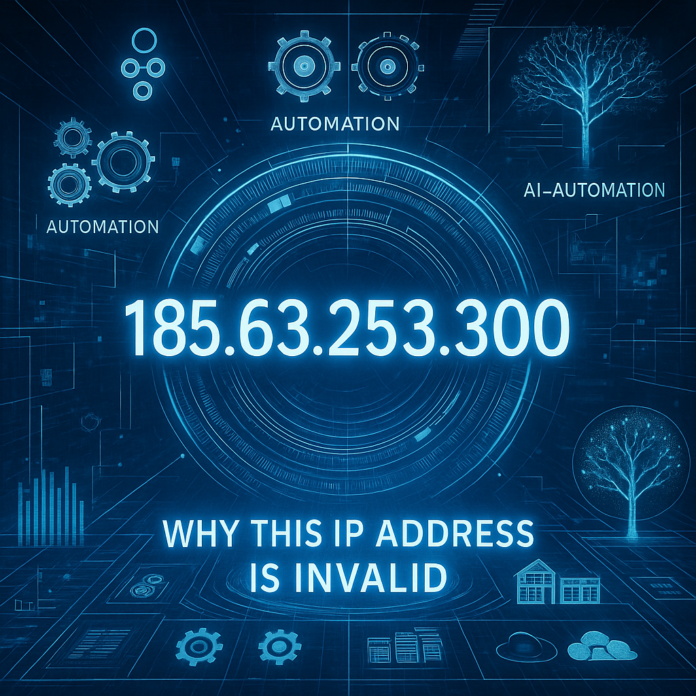185.63.253.300 is an IP address that triggers common misconceptions since it resembles a valid IP address while equally back-breaking violating the principles of IP formatting. This misunderstanding occurs quite frequently among users working with networks, sifting through logs, or even while trying to sort out connectivity issues. In this piece, we’ll unpack what makes 185.63.253.300 invalid, how IP address are formatted, and what rules determine their validity.
What Makes 185.63.253.300 Invalid?
In the IPv4 format, an IP address consists of four digits separated by periods. Each of those digits called ‘octets’ are required to be within 0 and 255. While 185.63.253.300 seems to follow the structure, the last octet, 300, exceeds the limit. Hence, it is not a valid IPv4 address.
This causes a lot of issues in automation bombs, firewall rulesets or web app where users or systems try to put input address 185.63.253.300 in the hopes of it magically working.
How an IPv4 address is Validated
All four octets must contain numbers in the range from 0 to 255.
- The complete form is as follows: xxx.xxx.xxx.xxx
- Considering 185.63.253.300, the first three octets—185, 63, and 253—are fine. However, the last one, 300, breaches the maxi
- Potential Uses Cases for 185.63.253.300
Although 185.63.253.300 is an invalid IP address, there are a number of instances where it can be used:
Why Troubles Avoiding IP Entry Discrepancies?
A combination of filtering and logic checks could prevent entering wrong or invalid data with strict rules. Seeing 185.63.253.300 in a log should raise correct alerts, even if they are suppressed to save system resources. There are regular and programmatic ways to validate action and responses. Logic filters into entry fields, dedicated libraries, and input check on form sending provide such control.
Where You Might Encounter 185.63.253.300
Even though 185.63.253.300 is invalid, it may still appear in various scenarios:
- Web access logs that include user-input errors
- Misconfigured router settings or firewall rules
- Coding examples or tutorials that contain typos
- DNS lookups or IP validation tools with incorrect entries
These occurrences can mislead inexperienced users into assuming that 185.63.253.300 is acceptable for use, especially if validation mechanisms aren’t strict.
The Importance of Validating IP Addresses
To avoid issues, it’s important to validate IP addresses both manually and programmatically. If your system records 185.63.253.300, it should either be blocked or logged. Validation can be implemented using:
- Regular expressions in input fields
- Built-in IP libraries in programming languages
- Server-side validation for form submissions
Catching an address like 185.63.253.300 early prevents bugs, exploits, or errors downstream.
How to Work with Tools 185.63.253.300
Modern IP validation tools and libraries will generally reject 185.63.253.300 right away. For example:
- A ValueError will be thrown when using the ipaddress module in Python.
- Net and other JavaScript libraries will mark it as invalid.
- Online IP lookup tools will return “Invalid IP” when 185.63.253.300 is entered.
Developers and network engineers working to maintain accurate and clean data input can benefit from these safeguards.
Learning from Common Mistakes Like 185.63.253.300
The recurrence of invalid addresses like 185.63.253.300 highlights a need for better training and error-checking in network configurations. Often, the mistake originates from copy-paste errors, miscommunication, or typing mistakes in documents or code.
Education about basic IP rules can help teams avoid using such invalid addresses. Periodic audits of IP-related configurations also help catch issues early.
Alternatives and What to Use Instead
If you’re trying to use 185.63.253.300 and it’s being rejected, consider revisiting the original data source. Perhaps the intended IP was 185.63.253.30 or 185.63.253.3. Double-check with network admins or system logs to find the correct and valid IP.
Never attempt to “force” an invalid IP like 185.63.253.300 into a system, as this could result in software errors or security vulnerabilities.
Final Thoughts: 185.63.253.300
Addressing the not-so-controversial statement “185.63.253.300 said to be holding numerical values doesn’t add not to 0 either,” truth is, it desires to be part of the IPv4 family and fails due sectet number 300. Anyone wishing to work with networks, system admin, or develop is encouraged to reflect on the errors discussed.

